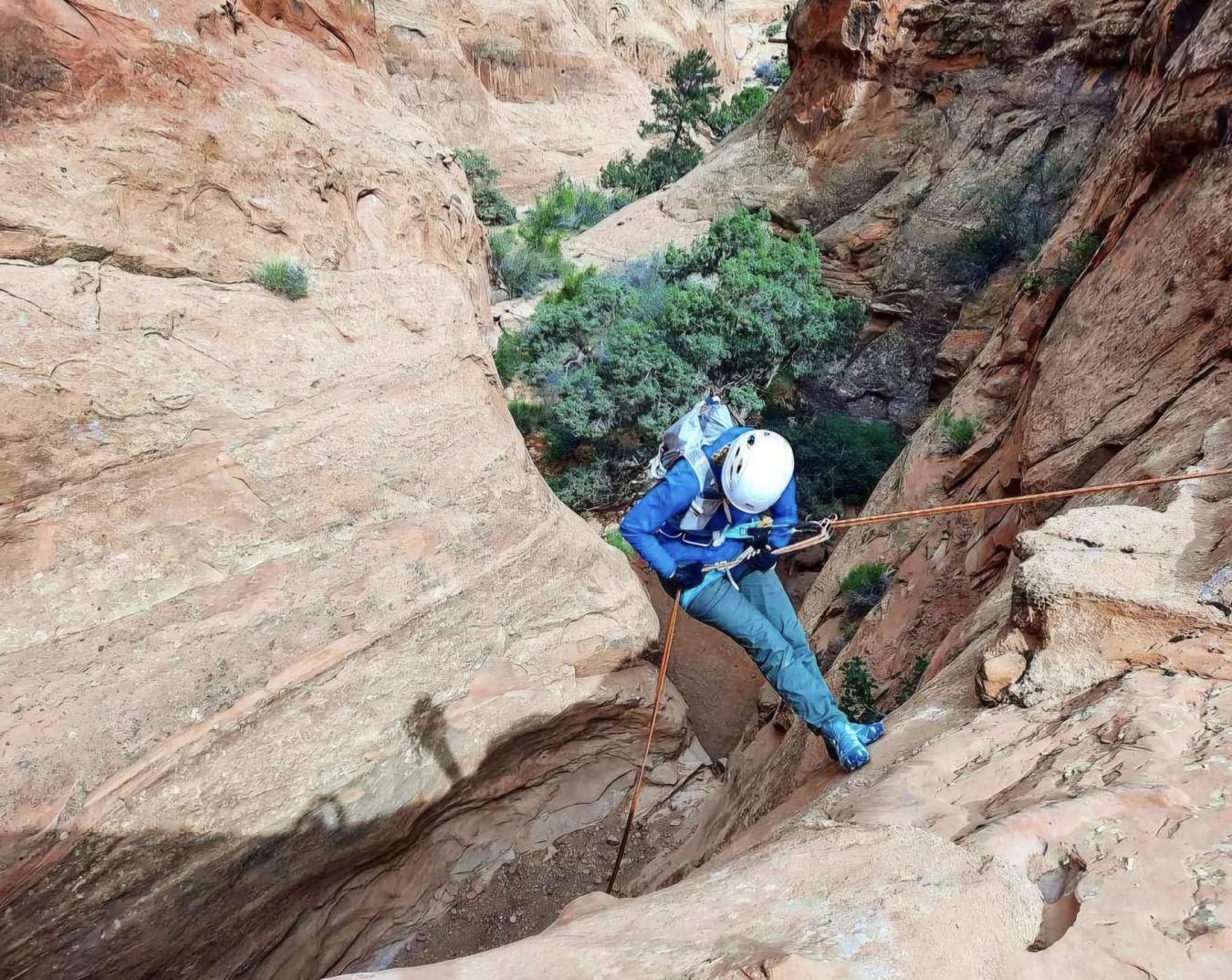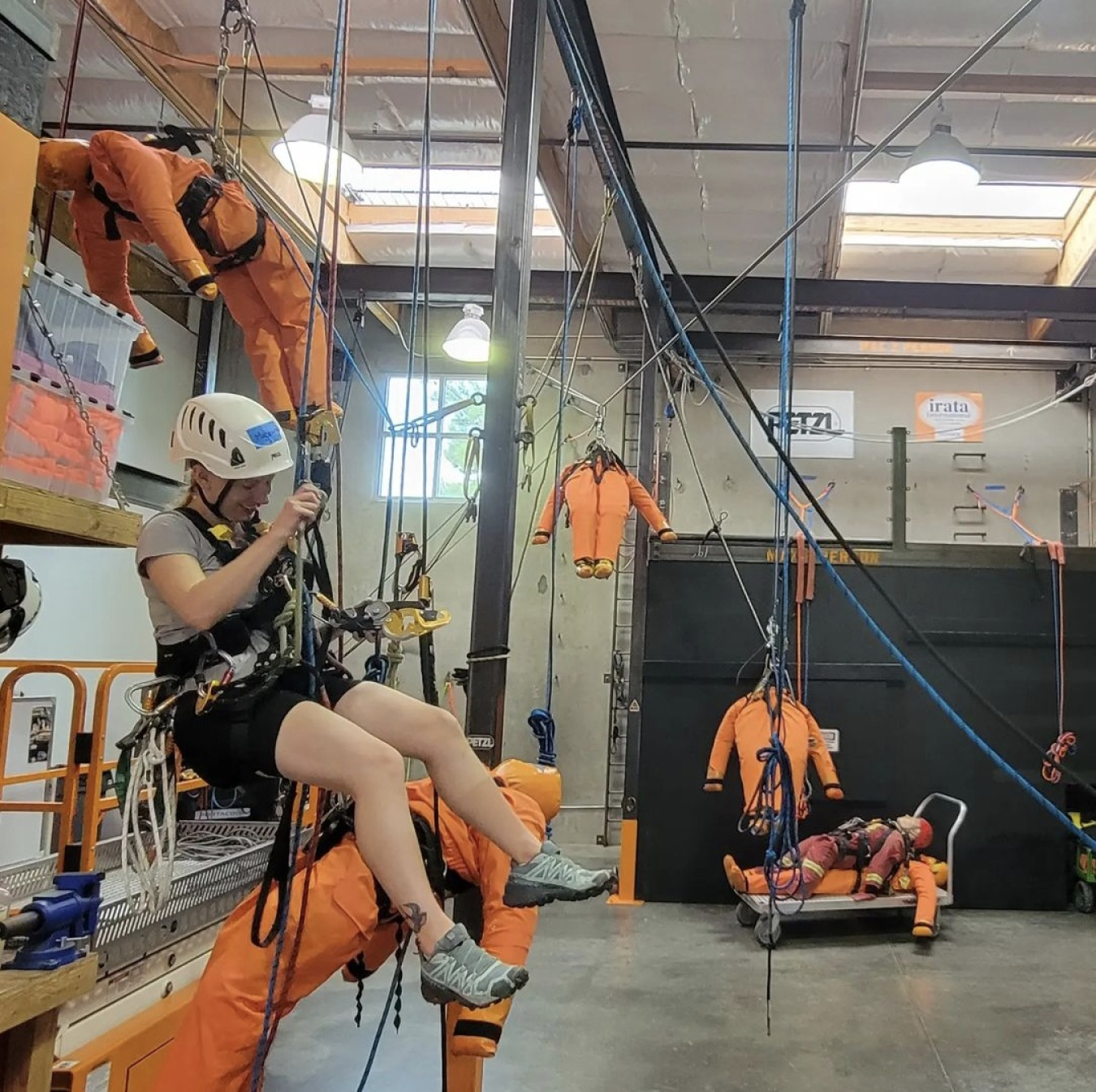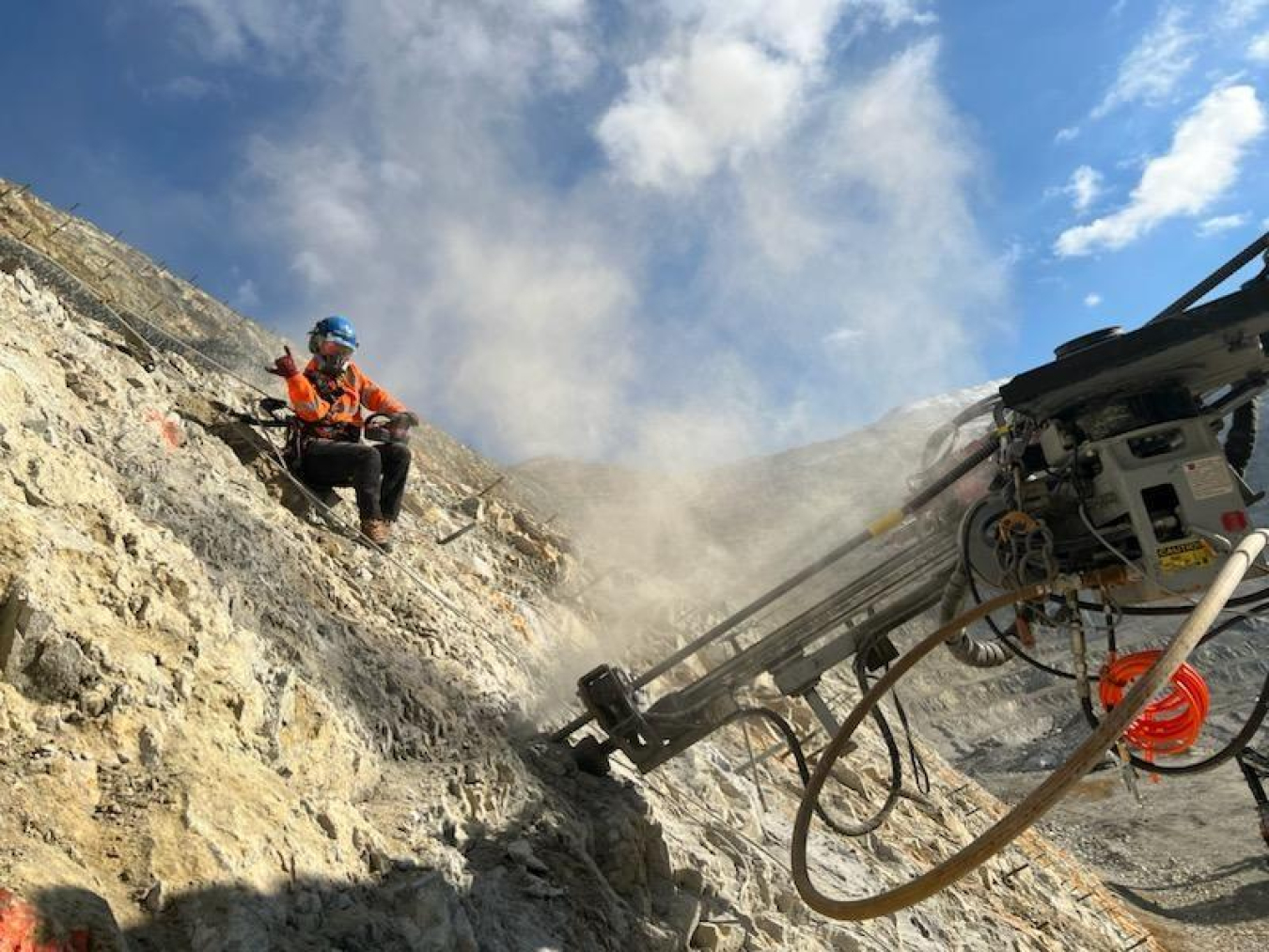Madeline Nelson, a project manager in the field of rope access geohazard mitigation, discusses her diverse career path that led to scaling rock walls and keeping hydropower dams safe.
Water Power Technologies Office
July 24, 2024Growing up, Madeline Nelson wanted to be a writer or an art museum curator—something artsy but practical. In high school, she veered toward media and graduated from college with degrees in journalism and broadcast production. Not long after, she landed a job at one of the big television networks. Things couldn’t go any better.

Ripple Effect
WPTO’s Ripple Effect series features individuals whose impactful work will help advance hydropower and marine energy technologies to achieve a clean energy future.
Then, in 2007, the Great Recession hit.
“I showed up to work and got in line with everyone else to be given my unemployment papers,” Nelson said. “That was a big blow.”
The recession wiped out Nelson’s original career goals. So, she started to build a new one, swapping TV sets and scripts for tasting rooms and bouquets: She became a sommelier. But a few years later, she lost her second career, too. This time, it was the COVID-19 pandemic that shuttered restaurants, weddings, and her prospects.
“I was put back on unemployment,” Nelson said. “During that time, I decided I didn’t want this to happen to me again. I would find work in an essential service.”
And she did.
Today, Nelson works as a project manager in an essential but little known field known as rope access geohazard mitigation. In this role, she oversees and often joins a team of expert climbers who don harnesses and hard hats and scale rock walls, dams, and other structures to prevent landslides, catch falling rocks, and repair critical infrastructure, like hydropower dams.
“We can’t hold mountains back, but we can do a lot to mitigate how they come down,” Nelson said.
In short, she’s a less flashy—but just as valuable—real-life Spiderwoman.
“The most challenging part of my job is emotionally processing the serious risks and possible need to apply our medical or rescue training during a potential emergency,” Nelson said.
In this Q&A, Nelson shared how she went from childhood van trips full of national parks and factory tours to scaling walls with hydraulic drills. Her field, geohazard mitigation, is critical to help keep hydropower operations running safely.
What did it feel like when you lost your job because of the Great Recession?
It was really disappointing. When you’re young and fresh and excited, you think you've got something. After that, I couldn’t get work. So, I took that time to reassess where I wanted to be in life.

What did you do next?
After traveling across the country for a while, I ended up moving to Washington state, which is where my mom is from. I still couldn’t find work. I was pretty much just going to take whatever came up, and I had the opportunity to work in a tasting room at a winery. One time, this man came in and started talking about the chemistry of how wine, trees, and wood all come together. Then, he told me about this thing called a sommelier.
I was freshly 21 at this time, so I started pursuing that. I got my sommelier certification and immediately found work. I worked at a resort, doing weddings and high-end fine dining and managing their beverage program and other conferences and events. That gave me a heavy foundation in the business operations side of events, sales trends, and company goals. It opened a lot of doors beyond just pouring wine.
Wow. Sounds like you built a new career from scratch, essentially.
Yeah. After a couple years, I moved on to a high-level management position at a local nonprofit that capitalized on agricultural tourism and the popularity of farm-to-table food services, but then the pandemic happened. The organization I worked for dissolved. It was kind of yo-yo work for a while, working at fine dining restaurants and managing their beverage programs, but restaurants shut down and then started back up for a few months and then shut down again. That’s when I decided I would find work in an essential service.
How did you choose which to go into?
My husband works in the rope access rockfall mitigation industry, and the company he was working for was looking for someone to do project management and fill in where needed in the field. With them, I went out on my first project in the Bingham Canyon mine. We were installing a very large mesh system to catch falling rocks and prevent landslides.
Was that a challenging transition to go from pouring wine to scaling rock walls?
I had been rock climbing and mountaineering as a side hobby for 10 years at this point, so the rope side was there. My current role is exciting because we’re starting a division from a basic skeleton. I support my field team on projects that help prevent catastrophic geologic failures that could threaten human life and critical infrastructure, but I also respond to geotechnical emergencies that support many industries, like hydropower, mining, and highways.
Are there any tie-ins to your previous job as a sommelier and business manager?
I’m able to bring in that logistic procurement side of things. I’m planning these projects, and there's always going to be something wild that's going to happen just like at a wedding. It might be a little boy taking a handful of cake before the bride and groom get to cut it. Or maybe a delivery date that didn’t work, and now we have to reorganize to still meet our deadline.
So how does hydropower fit into your day-to-day work?
I would say 90% of our projects have been in the hydropower space. If it were not for dams and the construction of dams, my role would simply not exist. The Grand Coulee Dam and the Hoover Dam required a lot of scaling, mesh installation, and protections for the powerhouses and infrastructure. To inspect the dams themselves, you often need rigging just to access them. At the Hoover Dam, there’s a statue of a rockfall mitigation technician in the visitor center with a little plaque that talks about how we still go out there and do maintenance scaling.

Do you ever get scared or just exhausted from doing such extreme work?
Yes, to all the above. We get theoretical ideas from our engineers for how we're going to stabilize or remove something. Once you get on the slope, those expectations might not align with reality. There's always inherent risk that comes with that. We’re working at heights. We’re trying to manipulate materials with rigging and rope and using physics to our advantage. When we’re scaling, we have to watch out for one another. You can't be below another person. You need to be in tune with your crew. A very simple mistake can be catastrophic. But we receive rescue training and severe trauma and wilderness first responder training.
What does your work on hydropower dams entail?
With my current company, our very first project was working above the Diablo Dam powerhouse in the North Cascades in Washington state. We went up an extremely hard, vertical granite wall to repair some damage that had occurred to their systems and install additional protection. The existing systems were installed back in the 1960s, so they had a good, long life. Then we reinstalled some new posts and did some general maintenance work. That was quite a beautiful place to be, spending the summer working above such an impressive piece of infrastructure that has been standing for so long.
Why is the work you do so important?
Without rockfall mitigation, we would see significantly more serious damage to critical infrastructure, and the people who work, live, and operate in these spaces could be at greater risk of serious injury or death. Rockfalls, landslides, and avalanches can be devastating. In the hydropower space, you do not want serious damage to your powerhouse or the dam itself, and you don’t want to critically injure the workers. If we don’t address these risks, there could be catastrophic consequences.
In an ideal world, what would you most hope to accomplish?
It’s quite special just having the chance to embrace these challenges, learn, and adapt to provide a service that has a real, tangible impact on the safety and daily lives of the communities we work with. I would like to continue down that path and see where it takes me.
What advice would you give to someone who might want to follow in your unusual footsteps?
Don’t be afraid to make changes. Sometimes it’s worth taking the risk when an opportunity presents itself, especially if it’s building on other skills you already possess. When you find the right person who’s willing to give you a chance, take it. Making that big change can be really scary, but it just takes patience.
Catch up on the Water Power Technologies Office’s (WPTO’s) other Ripple Effect profiles and the Office of Energy Efficiency and Renewable Energy’s Clean Energy Champions.
And stay in the know with WPTO! Receive the latest information on WPTO funding opportunities, events, and other news by subscribing to the bimonthly Hydro Headlines and Water Column newsletters, as well as the comprehensive, monthly Water Wire newsletter.

